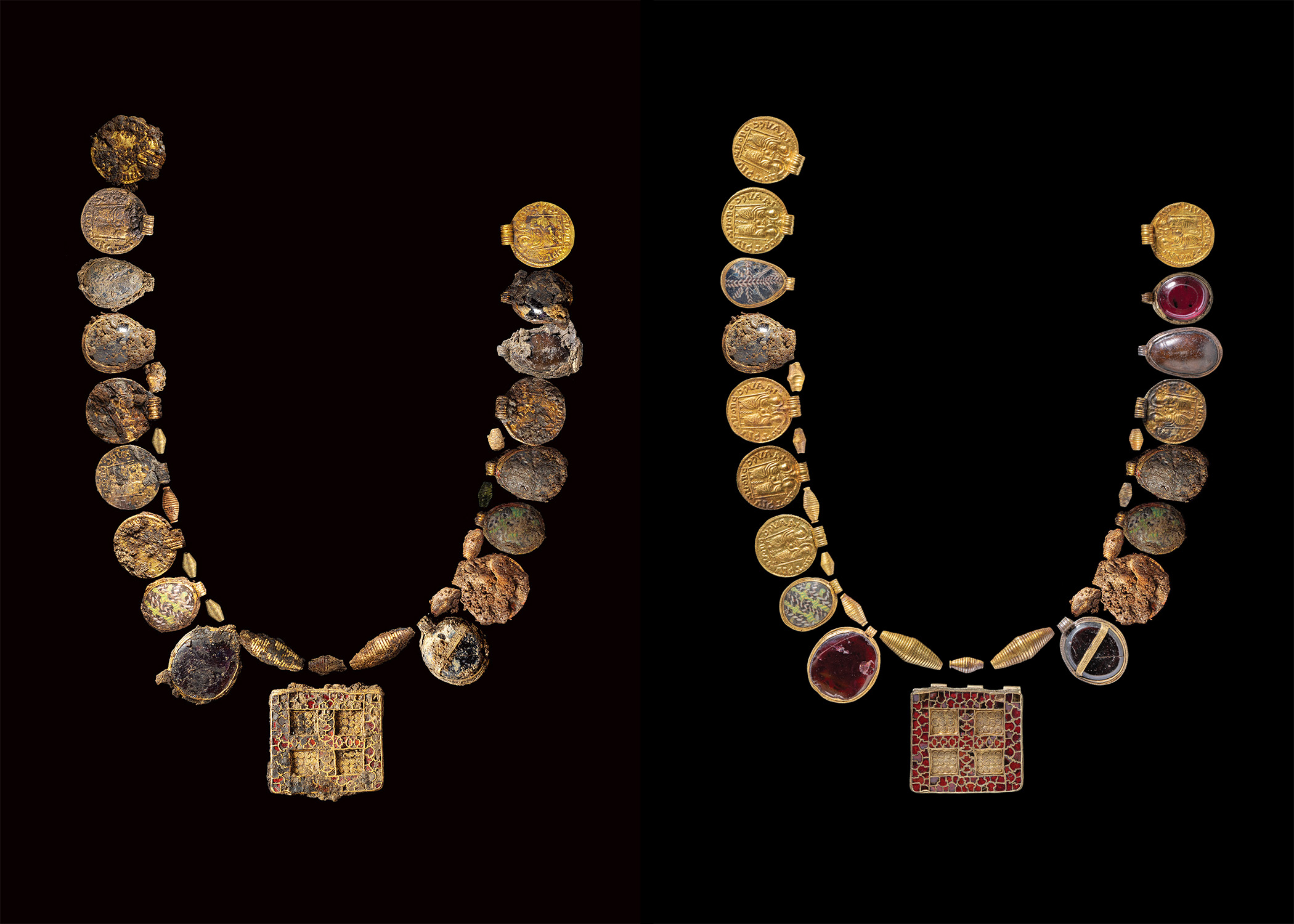Fantastické! 
Amazing pectoral and necklace in a seventh-century female tomb
Categories: Nálezy nejenom s detektorem ve Velké Británii a Irsku
A year of research into soil blocks from an early medieval grave discovered near the village of Harpole in Northamptonshire has yielded valuable new information and findings. Among them, a recently cleaned 1,300-year-old unique necklace with 30of gold, glass and gems, or a large silver breastplate with gold and garnet elements.
Possibly the most important early medieval female burial ever discovered in Britain, it has been under investigation for more than a year. The grave of an apparently high-profile woman, perhaps an abbess with royal origins, has been highlighted in several soil blocks which are being carefully studied and slowly dismantled in the laboratories of the Museum of London Archaeology (MOLA). Last year, a beautiful necklace of gold, garnets and semi-precious stones was discovered in one of the soil blocks, which experts say is unparalleled in Britain:
"When the first glimpses of gold began to emerge from the soil, we knew it was something significant. But we had no idea how special it would be. We're lucky enough to be able to use modern methods of analysis to get much deeper insight into the life of this person and their last rites," said Levente-Bence Balázs, director of the Museum of London Archaeology.
The centre of the necklace is a pendant with a cross motif. It is the largest and most intricate element of the entire piece of jewellery. It is made of red garnets set in a gold frame, the background of the cross is decorated with gold bead spirals. The pendants are made of gold, garnets, semi-precious stones, Roman gold coins (all from the reign of Theodosius I, 379-395 AD) and glass. They are separated by spacers made of gold wire. The necklace is the largest, finest and most decorative example of its kind.
"We have now completely cleaned most of the 30 pendants and beads that make up the extraordinary gold, glass and gemstone necklace buried with the deceased. The artefact was revealed in its full glory - revealing the intricate goldsmithing and rich colours of the semi-precious stones and coloured glass that the soil had previously concealed. One of the key questions is whether the pendants are original Roman coins or imitations of them, made specifically for this necklace," the MOLA website reports.
The burial also included two decorated pots and a shallow copper bowl. In addition, X-rays taken on blocks of soil lifted from the grave revealed another exciting find - theand richly decorated pectoral - a silver pectoral cross over 30 centimetres in size with very unusual depictions of human faces. The central cross is decorated with a smaller gold cross with one large and four smaller garnets. At the end of each arm are smaller circular crosses in silver with garnets and gold centres.
For the most part, the cross is made of extremely thin slices of silver attached to a wooden core, the severely degraded surface of which is now barely distinguishable from the surrounding ground. Experts hope that by identifying the type of wood used they will be able to better understand how the cross was built. Chest crosses are known from other lavish women's graves of the time, but the use of smaller crosses in the frameof a large cross is unique and suggests that its bearer may have had a privileged position in the Christian community.
Laboratory research has revealed other skeletal remains. Only a few teeth were discovered in the initial in situ excavation, but one of the soil blocks contained the upper part of a femur, a piece of pelvic bone, vertebrae, part of an arm and a wrist. The bones were suspended beneath a crushed copper bowl. The copper prevented much decomposition of the organic remains.
Experts continue to analyse and piece together the story of Harpo's burial. In addition to better understanding the objects found, they hope that scientific procedures can yield more information about the burial rituals of the time. In particular, the study of small fragments of organic matter may reveal new clues about the deceased, her clothing and what materials the grave goods were assembled from.
Roman Němec
Sources: mola.org.uk, thehistoryblog.com, mola-newsroom.prgloo.com

one of the pendants

a small silver face on a cross element

a reconstruction of a Harpol grave

main pendant - cross before and after cleaning

necklace before and after cleaning

part of the necklace collection

Harpol cross in situ and on X-ray

necklace in situ
The article is included in categories:



